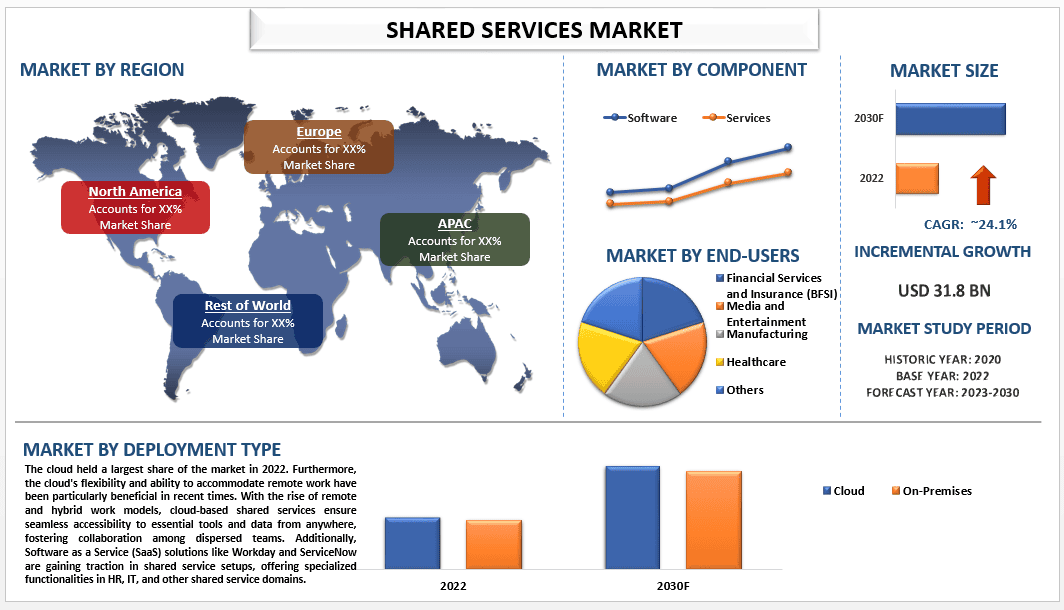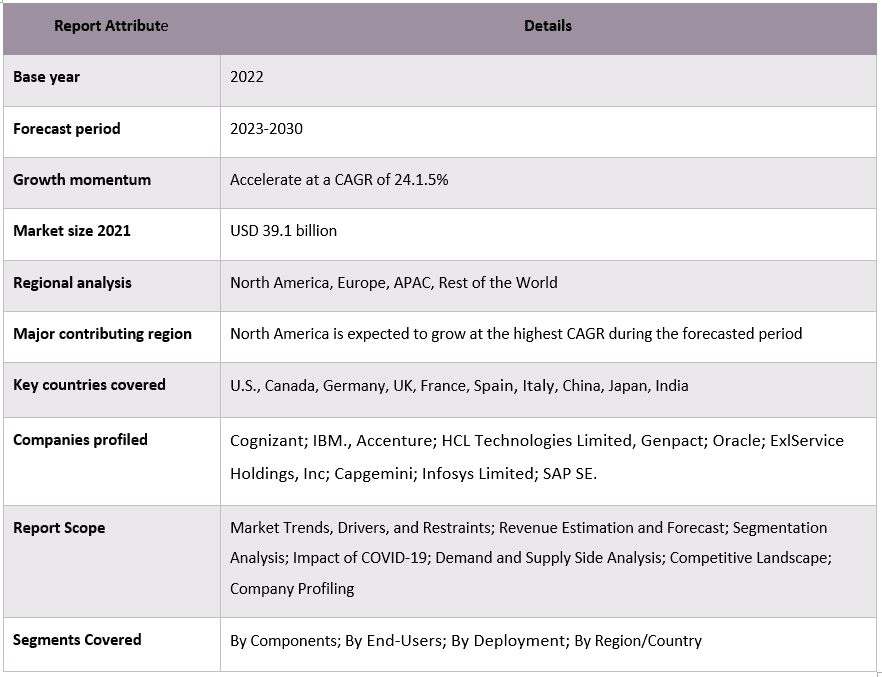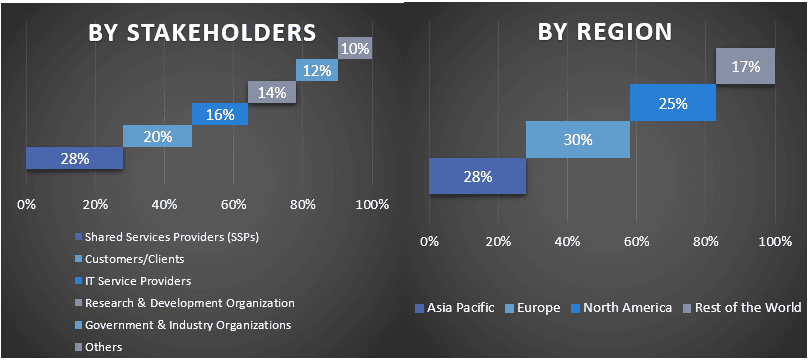Рынок общих центров обслуживания: текущий анализ и прогноз (2023-2030 гг.)
Акцент на компонентах (программное обеспечение и услуги); конечные пользователи (банковские, финансовые услуги и страхование (BFSI), СМИ и развлечения, производство, здравоохранение и другие); конечное использование (облако и локально); и регион/страна

Объем рынка общих центров обслуживания в 2022 году оценивался в 31,8 миллиарда долларов США и, как ожидается, будет расти со среднегодовым темпом роста около 24,1% в течение прогнозируемого периода. Во всем мире внедрение общих центров обслуживания продолжает расширяться в различных отраслях и географических регионах, что обусловлено стремлением к операционной эффективности, оптимизации затрат и улучшению качества обслуживания. Организации по всему миру признают преобразующий потенциал общих центров обслуживания в оптимизации процессов, консолидации операций и использовании эффекта масштаба. Этот глобальный всплеск обусловлен достижениями в области технологий, особенно появлением облачных вычислений, автоматизации и анализа данных, что позволяет центрам общих услуг выходить за географические границы и бесперебойно работать в различных регионах. Более того, пандемия COVID-19 ускорила внедрение общих центров обслуживания, поскольку компании перешли к удаленной работе, что вызвало переоценку операционных моделей и большую зависимость от цифровых решений.
В число основных игроков, работающих на рынке, входят Cognizant; IBM., Accenture; HCL Technologies Limited, Genpact; Oracle; ExlService Holdings, Inc; Capgemini; Infosys Limited; SAP SE. Эти игроки заключили несколько сделок по слияниям и поглощениям, а также партнерских соглашений, чтобы предоставить клиентам высокотехнологичные и инновационные продукты/технологии.
Основные сведения, представленные в отчете
“На основе компонентов рынок сегментирован на программное обеспечение и услуги. Среди них значительную долю рынка в 202 году занимал сегмент услуг2.”
На основе компонентов рынок сегментирован на программное обеспечение и услуги. Сегмент услуг имеет наибольшую долю рынка и, как ожидается, будет доминировать в течение прогнозируемого периода, что обусловлено стремлением к оптимизации операций и повышению экономической эффективности. Одной из важных тенденций, способствующих этому росту, является расширение глобального присутствия компаний. Поскольку бизнес охватывает различные географические регионы, потребность в программном обеспечении и услугах, способных поддерживать несколько языков, становится насущной. Компании все чаще инвестируют в услуги, адаптированные к конкретным языкам, такие как поддержка клиентов, услуги перевода и создание многоязычного контента.
“На основе конечных пользователей рынок сегментирован на BFSI, СМИ и развлечения, производство, здравоохранение и другие (коммунальные услуги, потребительские товары и образование). Среди них значительную долю рынка в 2022 году занимал сегмент BFSI.”
На основе конечных пользователей рынок сегментирован на BFSI, СМИ и развлечения, производство, здравоохранение и другие (коммунальные услуги, потребительские товары и образование). Сектор BFSI доминирует и имеет самую большую долю рынка. В секторе BFSI компании используют общие центры обслуживания для централизации бэк-офисных функций, таких как бухгалтерский учет, соответствие требованиям и поддержка клиентов. Благодаря консолидации этих операций финансовые учреждения достигают повышения экономической эффективности, стандартизируют процессы и расширяют свои возможности для преодоления нормативных сложностей. Общие центры обслуживания позволяют организациям BFSI оптимизировать ресурсы, улучшить качество обслуживания и переориентировать внимание на инновации и инициативы, ориентированные на клиентов.
Обзор отчета о рынке общих центров обслуживания

“Северная Америка занимает наибольшую долю на рынке общих центров обслуживания в 2022 году.”
Северная Америка будет занимать наибольшую долю рынка в 2022 году. Северная Америка является центром развития общих центров обслуживания, и корпорации в различных отраслях активно интегрируют эти модели в свои операционные структуры. Динамичная деловая среда региона способствовала широкому внедрению общих центров обслуживания. Различные отрасли, включая финансы, здравоохранение, технологии, телекоммуникации и производство, приняли общие центры обслуживания в качестве средства оптимизации операций, оптимизации ресурсов и повышения качества обслуживания. Совместный характер общих центров обслуживания произвел революцию в том, как работают североамериканские предприятия, позволяя им консолидировать ресурсы, стандартизировать процессы и сосредоточиться на основных компетенциях, повышая конкурентоспособность как на внутреннем, так и на мировом рынках. Например, в 2023 году TD Bank Group (TD) подтверждает свою приверженность укреплению своего технологического персонала, используя отношения с ключевыми организациями по подбору персонала и технических специалистов, такими как Black Professionals in Tech Network (BPTN) и FDM Group, чтобы и впредь помогать создавать мощный резерв разнообразных талантов и новых коллег.
Причины покупать этот отчет:
- Исследование включает в себя анализ размеров рынка и прогнозирования, подтвержденный проверенными ключевыми экспертами отрасли.
- Отчет представляет собой краткий обзор общей эффективности отрасли с первого взгляда.
- Отчет охватывает углубленный анализ видных игроков отрасли с уделением особого внимания ключевым финансовым показателям бизнеса, портфелям продуктов, стратегиям расширения и последним разработкам.
- Подробное изучение движущих сил, ограничений, ключевых тенденций и возможностей, преобладающих в отрасли.
- Исследование всесторонне охватывает рынок по различным сегментам.
- Углубленный анализ отрасли на региональном уровне.
Варианты персонализации:
Глобальный рынок общих центров обслуживания может быть дополнительно настроен в соответствии с требованиями или любым другим сегментом рынка. Кроме того, UMI понимает, что у вас могут быть свои собственные бизнес-потребности, поэтому не стесняйтесь обращаться к нам, чтобы получить отчет, который полностью соответствует вашим требованиям.
Содержание
Методология исследования для анализа рынка общих центров обслуживания (2022-2030 гг.)
Анализ исторического рынка, оценка текущего рынка и прогнозирование будущего рынка глобального рынка общих центров обслуживания были тремя основными шагами, предпринятыми для создания и анализа внедрения общих центров обслуживания в основных регионах мира. Было проведено тщательное вторичное исследование для сбора исторических данных о рынке и оценки текущего размера рынка. Во-вторых, для подтверждения этих выводов было принято во внимание множество результатов и предположений. Кроме того, были проведены исчерпывающие первичные интервью с отраслевыми экспертами по всей цепочке создания стоимости глобального рынка общих центров обслуживания. После предположения и подтверждения рыночных показателей посредством первичных интервью мы использовали подход «сверху вниз»/«снизу вверх» для прогнозирования полного размера рынка. После этого были приняты методы декомпозиции рынка и триангуляции данных для оценки и анализа размера рынка сегментов и подсегментов соответствующей отрасли. Подробная методология описана ниже:
Анализ исторического размера рынка
Шаг 1: Углубленное изучение вторичных источников:
Было проведено подробное вторичное исследование для получения исторических данных о размере рынка общих центров обслуживания из внутренних источников компании, таких как годовые отчеты и финансовая отчетность, презентации результатов деятельности, пресс-релизы и т. д., и внешних источников, включая журналы, новости и статьи, правительственные публикации, публикации конкурентов, отраслевые отчеты, сторонние базы данных и другие надежные публикации.
Шаг 2: Сегментация рынка:
После получения исторических данных о размере рынка общих центров обслуживания мы провели подробный вторичный анализ для сбора исторических данных о рынке и доле для различных сегментов и подсегментов в основных регионах. Основные сегменты, включенные в отчет, разделены по компонентам, конечным пользователям и развертыванию. Был проведен дальнейший анализ на уровне стран для оценки общего внедрения моделей тестирования в этом регионе.
Шаг 3: Факторный анализ:
После получения исторических данных о размере рынка различных сегментов и подсегментов мы провели подробный факторный анализ для оценки текущего размера рынка общих центров обслуживания. Кроме того, мы провели факторный анализ с использованием зависимых и независимых переменных, таких как компоненты, конечные пользователи и развертывание рынка общих центров обслуживания. Был проведен тщательный анализ сценариев спроса и предложения с учетом основных партнерств, слияний и поглощений, расширения бизнеса и запуска продуктов в секторе рынка общих центров обслуживания по всему миру.
Оценка и прогноз текущего размера рынка
Определение текущего размера рынка: на основе практически применимых выводов, полученных на основе вышеуказанных 3 шагов, мы определили текущий размер рынка, ключевых игроков на глобальном рынке общих центров обслуживания и доли рынка сегментов. Все необходимые процентные доли, разбивки и декомпозиции рынка были определены с использованием вышеупомянутого вторичного подхода и были проверены посредством первичных интервью.
Оценка и прогнозирование: для оценки и прогнозирования рынка различным факторам были присвоены веса, включая драйверы и тенденции, ограничения и возможности, доступные для заинтересованных сторон. После анализа этих факторов были применены соответствующие методы прогнозирования, т. е. подход «сверху вниз»/«снизу вверх», чтобы получить прогноз рынка на 2030 год для различных сегментов и подсегментов на основных рынках по всему миру. Методология исследования, принятая для оценки размера рынка, включает в себя:
- Размер рынка отрасли с точки зрения выручки (в долларах США) и темпы внедрения рынка общих центров обслуживания на основных рынках внутри страны
- Все процентные доли, разбивки и декомпозиции сегментов и подсегментов рынка
- Ключевые игроки на глобальном рынке общих центров обслуживания с точки зрения предлагаемых продуктов. Кроме того, стратегии роста, принятые этими игроками для конкуренции на быстрорастущем рынке
Подтверждение размера рынка и доли рынка
Первичное исследование: были проведены углубленные интервью с ключевыми лидерами мнений (KOL), включая руководителей высшего звена (CXO/вице-президенты, руководители отдела продаж, руководители отдела маркетинга, руководители операционного отдела, региональные руководители, руководители стран и т. д.) в основных регионах. Затем результаты первичного исследования были обобщены и был выполнен статистический анализ для доказательства заявленной гипотезы. Входные данные из первичного исследования были объединены с вторичными результатами, таким образом, информация превратилась в практически применимые выводы.
Разделение первичных участников по различным регионам

Инжиниринг рынка
Метод триангуляции данных был использован для завершения общей оценки рынка и получения точных статистических данных для каждого сегмента и подсегмента глобального рынка общих центров обслуживания. Данные были разделены на несколько сегментов и подсегментов после изучения различных параметров и тенденций в областях компонентов, конечных пользователей и развертывания на глобальном рынке общих центров обслуживания.
Основная цель исследования глобального рынка общих центров обслуживания
В исследовании были точно определены текущие и будущие тенденции глобального рынка общих центров обслуживания. Инвесторы могут получить стратегические выводы, чтобы основывать свое усмотрение для инвестиций на качественном и количественном анализе, выполненном в исследовании. Текущие и будущие тенденции рынка определили общую привлекательность рынка на региональном уровне, предоставив промышленному участнику платформу для использования неиспользованного рынка для получения выгоды от преимущества первопроходца. Другие количественные цели исследований включают в себя:
- Анализ текущего и прогнозируемого размера рынка общих центров обслуживания с точки зрения стоимости (в долларах США). Кроме того, анализ текущего и прогнозируемого размера рынка различных сегментов и подсегментов.
- Сегменты в исследовании включают области компонентов, конечных пользователей и развертывания.
- Определение и анализ нормативно-правовой базы для индустрии общих центров обслуживания.
- Анализ цепочки создания стоимости, связанной с присутствием различных посредников, а также анализ поведения клиентов и конкурентов отрасли.
- Анализ текущего и прогнозируемого размера рынка общих центров обслуживания для основного региона.
- Основные страны регионов, изученные в отчете, включают Азиатско-Тихоокеанский регион, Европу, Северную Америку и остальной мир
- Профили компаний рынка общих центров обслуживания и стратегии роста, принятые участниками рынка для поддержания устойчивости на быстрорастущем рынке.
- Углубленный анализ отрасли на региональном уровне
Часто задаваемые вопросы Часто задаваемые вопросы
В1: Каков текущий размер рынка и потенциал роста глобального рынка общих центров обслуживания?
Q2: Какие движущие факторы способствуют росту глобального рынка общих центров обслуживания?
В3: Какой сегмент имеет наибольшую долю на мировом рынке общих центров обслуживания по компонентам?
В5: Какая страна будет доминировать на мировом рынке общих центров обслуживания?
В6: Кто является ключевыми игроками, работающими на глобальном рынке общих центров обслуживания?
Связанные Отчеты
Клиенты, купившие этот товар, также купили










